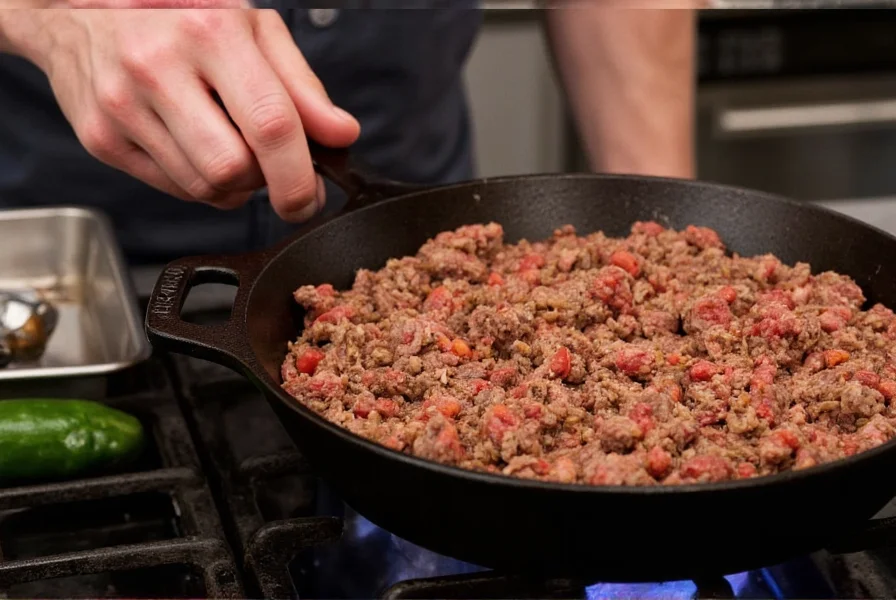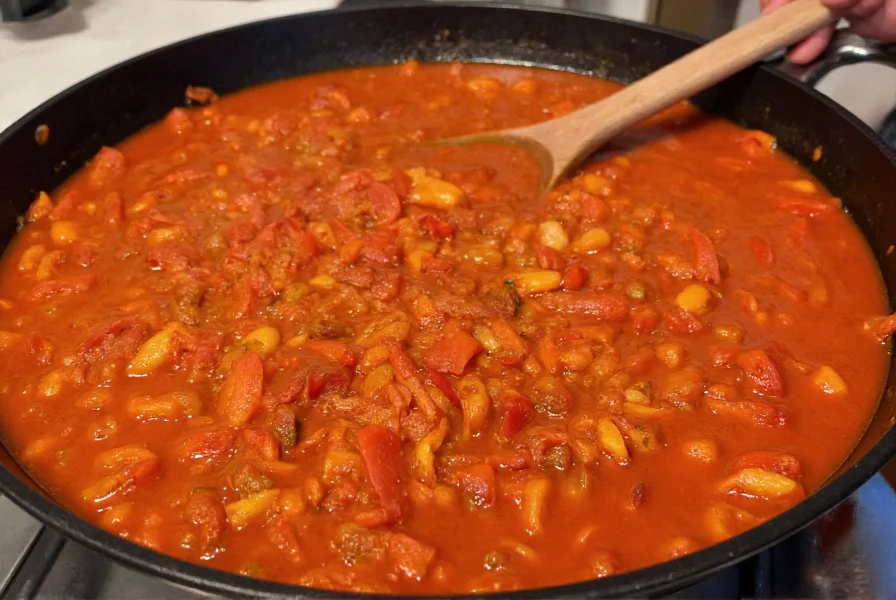The Essential Elements of Perfect Chili
Creating exceptional chili isn't just about throwing ingredients into a pot—it's about understanding flavor development and technique. The foundation of any great chili recipe starts with proper meat browning. When preparing easy homemade chili recipes, take time to sear your ground beef in batches to achieve that crucial Maillard reaction, which creates complex flavor compounds no spice blend can replicate.
Acidity balance separates good chili from extraordinary chili. While many quick weeknight chili recipes rely solely on canned tomatoes, professional chefs often add a splash of apple cider vinegar or even a small amount of unsweetened chocolate during the final simmering stage. This subtle acidity brightens the rich, heavy flavors without making the chili taste sour.

Classic Texas-Style Beef Chili Recipe
This authentic Texas chili recipe without beans honors the Lone Star State tradition where beans are considered an abomination to true chili con carne. The secret lies in using chuck roast cut into small cubes rather than ground beef, which provides superior texture and richer flavor as the connective tissues break down during slow cooking.
| Prep Time | Cook Time | Servings | Difficulty |
|---|---|---|---|
| 25 minutes | 3 hours | 6-8 | Intermediate |
Ingredients
- 2 lbs beef chuck, cut into 1/2-inch cubes
- 3 tbsp chili powder (preferably ancho)
- 2 tbsp smoked paprika
- 1 tbsp ground cumin
- 4 cloves garlic, minced
- 28 oz crushed fire-roasted tomatoes
- 1 cup dark beer or beef stock
- 2 dried guajillo chilies, stemmed and soaked
- 1 tsp Mexican oregano
- Salt to taste
Step-by-Step Instructions
- Pat beef cubes dry and season generously with salt. Working in batches, brown meat on all sides in a heavy Dutch oven over medium-high heat. Remove and set aside.
- Using the same pot, toast chili powder, paprika, and cumin for 30 seconds until fragrant. Add garlic and cook until golden.
- Return beef to pot along with any accumulated juices. Add tomatoes, beer, soaked chilies, and oregano.
- Bring to a gentle simmer, then reduce heat to low. Cover partially and cook for 2.5-3 hours until meat is fork-tender.
- Remove whole chilies. Using an immersion blender, carefully blend 1/3 of the chili to thicken the base while maintaining texture.
- Season with additional salt if needed and let rest for 15 minutes before serving.
Three Popular Chili Variations for Every Cook
Vegetarian Three-Bean Chili
This healthy vegetarian chili recipe satisfies meat-eaters and vegetarians alike with its hearty texture and deep flavors. Substitute beef with 1 cup each of kidney beans, black beans, and pinto beans (drained and rinsed). Add 2 cups diced mushrooms and 1 cup cooked lentils for meaty texture. For umami depth, include 2 tbsp soy sauce or tamari and 1 tsp liquid smoke. Simmer for 45 minutes to allow flavors to meld.
White Chicken Chili with Green Chile
For those seeking lighter chili recipes for cold weather, this version uses chicken thighs instead of beef. Brown 1.5 lbs boneless chicken thighs, then remove. Sauté 1 diced onion, 2 diced poblano peppers, and 4 minced garlic cloves. Add 4 cups chicken stock, 2 cans white beans (drained), 1 can green chilies, and the juice of 1 lime. Return chicken to pot and simmer 45 minutes. Stir in fresh cilantro before serving.

Slow Cooker Cincinnati-Style Chili
Cincinnati's unique spaghetti-topped chili recipe features Mediterranean spices uncommon in other regional styles. Brown 2 lbs ground beef with 1 diced onion. Transfer to slow cooker with 28 oz crushed tomatoes, 2 cups beef broth, 2 tbsp cocoa powder, 1 tbsp cinnamon, 1 tsp allspice, and 1/4 tsp cloves. Cook on low 6-8 hours. Serve over spaghetti with shredded cheddar and oyster crackers.
Common Chili Mistakes and How to Fix Them
Even experienced cooks make these chili cooking mistakes that compromise flavor:
- Using cold ingredients: Always bring canned tomatoes and other refrigerated items to room temperature before adding to prevent temperature shock that stops cooking processes
- Over-relying on pre-mixed chili powder: Create your own blend using equal parts ancho chili powder, cumin, and smoked paprika with touches of cayenne and Mexican oregano
- Skipping the resting period: Chili always tastes better the next day as flavors continue to meld—plan accordingly for special occasions
- Adding beans too early: If using beans, add them during the last 30 minutes of cooking to prevent mushiness
Serving and Storage Tips for Perfect Chili Every Time
Authentic chili enthusiasts know that proper chili serving techniques elevate the experience. Always provide multiple topping options: shredded cheese, sour cream, diced onions, fresh cilantro, and lime wedges allow guests to customize. For thicker chili suitable for chili dogs or nachos, reduce liquid content by 25% and simmer uncovered for the final 30 minutes.
When storing, chili's flavors deepen over time. Cool completely before transferring to airtight containers. Properly stored make-ahead chili recipes maintain quality for up to 5 days in the refrigerator or 3 months in the freezer. When reheating, add a splash of broth or water to restore ideal consistency.
What's the secret to making chili less acidic?
To reduce acidity in chili without compromising flavor, add 1/4 teaspoon of baking soda during the final 15 minutes of cooking. Alternatively, a small amount of unsweetened chocolate (about 1 square) or a teaspoon of honey can balance acidity naturally while enhancing overall flavor complexity.
How can I make my chili thicker without adding flour?
For naturally thicker chili, try mashing some of the beans before adding them, using tomato paste instead of diced tomatoes, or simmering uncovered for the final 20-30 minutes. Another professional technique is to blend 1 cup of the cooked chili and return it to the pot, which thickens the base while maintaining texture.
What's the difference between chili powder and chili seasoning?
Chili powder is primarily ground dried chilies (often ancho), while chili seasoning contains additional ingredients like cumin, garlic powder, and oregano. For authentic flavor control, start with pure chili powder and build your own spice blend, adjusting ratios to match regional styles—Texas chili uses more pure chili powder, while Cincinnati style incorporates Mediterranean spices.
Can I make great chili without tomatoes?
Yes, traditional Texas chili con carne contains no tomatoes. For tomato-free chili, increase your use of roasted red peppers or fire-roasted poblano peppers to provide natural sweetness and depth. Use beef or chicken stock as your liquid base instead of tomato products, and consider adding a small amount of unsweetened chocolate for richness.
How do I fix chili that's too spicy?
If your chili is too spicy, add dairy products like sour cream or shredded cheese directly to individual servings. For the entire batch, stir in 1/2 cup of full-fat coconut milk or heavy cream. Acidic elements like lime juice or apple cider vinegar can also help balance excessive heat. Never add water, as it dilutes flavor without reducing spiciness effectively.











 浙公网安备
33010002000092号
浙公网安备
33010002000092号 浙B2-20120091-4
浙B2-20120091-4